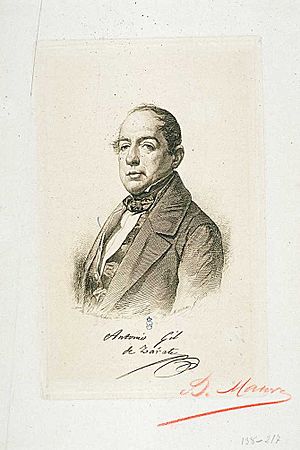Antonio Gil y Zárate facts for kids
Quick facts for kids
The Most Excellent
Antonio Gil
|
|
|---|---|
 |
|
| Born |
Antonio Gil y Zárate
14 January 1793 El Escorial, Spain
|
| Died | 27 January 1861 (aged 68) Madrid, Spain
|
| Seat P of the Real Academia Española | |
| In office 1841 – 27 January 1861 |
|
| Preceded by | Agustín José Mestre |
| Succeeded by | Antonio García Gutiérrez |
Antonio Gil y Zárate (born in 1793, died in 1861) was a famous Spanish writer and teacher. He wrote plays, especially tragedies, during a time called Romanticism. His most well-known play was Guzmán el Bueno, which was about a brave Spanish hero from the Middle Ages.
He was also a member of important Spanish academies, like the Real Academia Española. A mineral called Zaratite was even named after him!
Contents
Early Life and Education
Antonio Gil y Zárate was born in El Escorial, Spain, in 1793. His father, Bernardo Gil, was a well-known actor in Madrid. Antonio's mother, Ántonia Zárate, passed away when he was young. His father then married another famous actress, Antera Baus. Because of this, Antonio grew up surrounded by the world of theatre in Madrid.
As a young person, Antonio spent several years studying in France. He also studied physics and mathematics in Madrid, Spain. He went back to France for two more years to continue his studies. During this time, he enjoyed reading the newest French books and plays. After returning to Spain, Antonio first tried to get involved in politics. However, he soon started writing plays instead.
His Career as a Writer
Antonio Gil y Zárate wrote his first play, a comedy called La Cómico-Manía, in 1816. People liked it and encouraged him to write more. In the mid-1820s, he faced challenges with censorship. This meant that some of his work was opposed, especially by the Catholic Church. For a few years, he taught French at a school in Madrid to earn money. This helped him until things became easier for writers.
Later, he wrote Blanca de Borbón, which was performed in 1835. His play Carlos II el Hechizado came out in 1837 and was very popular. This play was about a Spanish king.
The 1830s and 1840s were his busiest years for writing. His plays were extremely popular then. His play, Guzmán el Bueno. Drama en Cuatro Actos, was considered his most important work. It was set in the Middle Ages and told the story of Alonso Pérez de Guzmán. He was a national hero of Spain, and his story had been told in many plays and books before.
Joining the Royal Spanish Academy
Antonio Gil y Zárate became an honorary member of the Real Academia Española in 1839. This is a very important group that looks after the Spanish language. In 1841, he became a full member.
He worked with two other members, Manuel Bretón de los Herreros and Ventura de la Vega. Together, they created new rules for the Academy. These new rules were approved in 1848.
The Pidal Plan for Education
Antonio Gil y Zárate also played a big role in changing Spain's education system. He created what was called the Pidal Plan in 1845. This plan was named after his friend and mentor, Pedro José Pidal, who was Spain's Minister of the Interior.
The Pidal Plan was the first major update to education in Spain. It led to the Ley Moyano in 1857, which was a very important law for schools. The plan said that state-run high schools, called institutos, should be created in every main city of a province.
The plan also changed what students learned.
- Spanish literature was added for high school students.
- Geography and Spanish history were added for both high school and university students.
This plan also created the first university position for International Law. A person named Lorenzo Arrazola y García held this job for a short time. He later became a Prime Minister of Spain.
His Main Works
- La Cómico-Manía, 1816
- La Familia Catalana
- Él Entremetido, 1825
- Blanca de Borbon, 1829
- Carlos II el Hechizado, 1837
- Guzmán el Bueno. Drama en Cuatro Actos, 1840s
See also
 In Spanish: Antonio Gil y Zárate para niños
In Spanish: Antonio Gil y Zárate para niños

